Related Research Articles

4183 Cuno, provisional designation 1959 LM, is an eccentric, rare-type asteroid, classified as near-Earth object and potentially hazardous asteroid of the Apollo group, and measures approximately 4 kilometers in diameter.
(68950) 2002 QF15 is a stony asteroid, classified as near-Earth object and potentially hazardous asteroid of the Apollo group, that measures approximately 2 kilometers in diameter. It was discovered on 27 August 2002, by the LINEAR project at Lincoln Laboratory's Experimental Test Site in Socorro, New Mexico, United States.
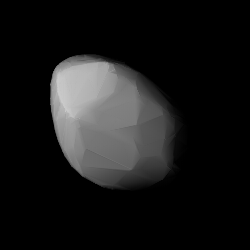
1685 Toro is an asteroid and near-Earth object of the Apollo group on an eccentric orbit. It was discovered on 17 July 1948, by American astronomer Carl Wirtanen at Lick Observatory on Mount Hamilton, California. The stony S-type asteroid has a rotation period of 10.2 hours and measures approximately 4 kilometers in diameter. It is named for Betulia Toro Herrick, wife of astronomer Samuel Herrick. The Sylacauga meteorite appears to have originated from this asteroid.
5011 Ptah is a near-Earth object and potentially hazardous asteroid of the Apollo group. It was discovered by astronomers with the Palomar–Leiden survey on 24 September 1960. The rare O-type asteroid on an eccentric orbit measures approximately 1.6 kilometers in diameter. It was named after the Ancient Egyptian deity Ptah.
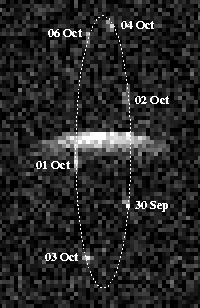
(185851) 2000 DP107 is a sub-kilometer sized asteroid, classified as potentially hazardous asteroid and near-Earth object of the Apollo group that is notable because it provided evidence for binary asteroids in the near-Earth population. The PROCYON probe developed by JAXA and the University of Tokyo was intended to flyby this asteroid before its ion thruster failed and could not be restarted.
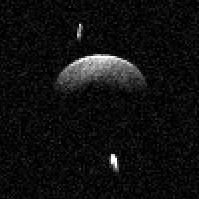
(153591) 2001 SN263 is a carbonaceous trinary asteroid, classified as near-Earth object and former potentially hazardous asteroid of the Amor group, approximately 2.6 kilometers (1.6 miles) in diameter. It was discovered by the Lincoln Near-Earth Asteroid Research project at Lincoln Lab's Experimental Test Site in Socorro, New Mexico, on 20 September 2001. The two synchronous minor-planet moons measure approximately 770 and 430 meters and have an orbital period of 16.46 and 150 hours, respectively.
8034 Akka, provisional designation 1992 LR, is a sub-kilometer sized, eccentric asteroid and near-Earth object of the Apollo group, approximately 540 meters in diameter. It was discovered at Palomar Observatory in 1992, and named after Akka from Finnish mythology.
1864 Daedalus, provisional designation 1971 FA, is a stony asteroid and near-Earth object of the Apollo group, approximately 3 kilometers in diameter. It was discovered on 24 March 1971, by Dutch–American astronomer Tom Gehrels at Palomar Observatory, California, and named after Daedalus from Greek mythology.
8013 Gordonmoore, provisional designation 1990 KA, is an eccentric, stony asteroid and near-Earth object of the Apollo group, approximately 1–2 kilometers in diameter.
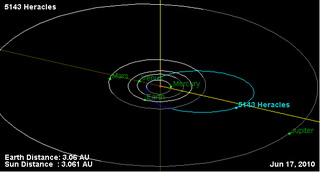
5143 Heracles is a highly eccentric, rare-type asteroid and synchronous binary system, classified as near-Earth object of the Apollo group, approximately 4.8 kilometers in diameter. The asteroid was discovered on 7 November 1991, by American astronomer Carolyn Shoemaker at Palomar Observatory in California, United States. It is named for the Greek divine hero Heracles. It has an Earth minimum orbit intersection distance of 0.058 AU (8.7 million km) and is associated with the Beta Taurids daytime meteor shower.
(5646) 1990 TR is a probable rare-type binary asteroid classified as near-Earth object of the Amor group, approximately 2.3 kilometers in diameter. It was discovered on 11 October 1990, by Japanese astronomers Seiji Ueda and Hiroshi Kaneda at Kushiro Observatory near Kushiro, in eastern Hokkaido, Japan.
(6037) 1988 EG is an eccentric, stony asteroid, classified as near-Earth object and potentially hazardous asteroid. It belongs to the group of Apollo asteroids and measures approximately half a kilometer in diameter. It was discovered by American astronomer Jeff T. Alu at the U.S. Palomar Observatory, California, on 12 March 1988.
(467336) 2002 LT38, is a sub-kilometer asteroid and suspected tumbler, classified as a near-Earth object and potentially hazardous asteroid of the Aten group, approximately 240 meters (790 ft) in diameter. It was discovered on 12 June 2002, by astronomers of the Lincoln Near-Earth Asteroid Research at the Lincoln Laboratory's Experimental Test Site near Socorro, New Mexico, in the United States.
(10115) 1992 SK, is a stony near-Earth object and potentially hazardous asteroid on an eccentric orbit. It belongs to the group of Apollo asteroids and measures approximately 1 kilometer in diameter. It was discovered by American astronomers Eleanor Helin and Jeff Alu at the Palomar Observatory in California on 24 September 1992.
(86039) 1999 NC43 (provisional designation 1999 NC43) is an asteroid on an eccentric orbit, classified as near-Earth object and potentially hazardous asteroid of the Apollo group, approximately 2 kilometers in diameter. This suspected tumbler and relatively slow rotator was discovered by LINEAR in 1999.
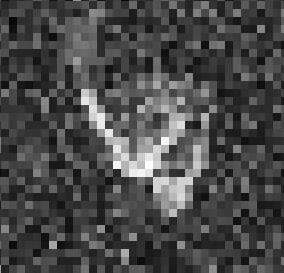
(192642) 1999 RD32, provisional designation: 1999 RD32, is an asteroid and suspected contact binary on an eccentric orbit, classified as a large near-Earth object and potentially hazardous asteroid of the Apollo group, approximately 5 kilometers (3 miles) in diameter. It was discovered on 8 September 1999, at a magnitude of 18, by astronomers of the LINEAR program using its 1-meter telescope at the Lincoln Laboratory's Experimental Test Site near Socorro, New Mexico, United States. The asteroid is likely of carbonaceous composition and has a rotation period of 17.08 hours.
(16960) 1998 QS52 (provisional designation 1998 QS52) is a stony asteroid on a highly eccentric orbit, classified as near-Earth object and potentially hazardous asteroid of the Apollo group, approximately 4.1 kilometers (2.5 mi) in diameter. It was discovered on 25 August 1998, by astronomers of the LINEAR program at Lincoln Laboratory's Experimental Test Site near Socorro, New Mexico, in the United States. This asteroid is one of the largest potentially hazardous asteroid known to exist.
(90075) 2002 VU94 (provisional designation 2002 VU94) is an asteroid on an eccentric orbit, classified as near-Earth object and potentially hazardous asteroid of the Apollo group, approximately 2.5 kilometers in diameter. It was discovered on 13 November 2002, by astronomers of the Near-Earth Asteroid Tracking program at Palomar Observatory in California, United States. It is one of the largest potentially hazardous asteroids known.
(143651) 2003 QO104, provisional designation 2003 QO104, is a stony asteroid, slow rotator and suspected tumbler on a highly eccentric orbit, classified as near-Earth object and potentially hazardous asteroid of the Amor and Apollo group, respectively. It was discovered on 31 August 2003, by astronomers of the Near-Earth Asteroid Tracking program at the Haleakala Observatory in Hawaii, United States. The Q-type asteroid has a rotation period of 114.4 hours and possibly an elongated shape. It measures approximately 2.3 kilometers (1.4 miles) in diameter and belongs the largest potentially hazardous asteroids known to exist.
(385343) 2002 LV, provisional designation 2002 LV, is a stony asteroid on a highly eccentric orbit, classified as near-Earth object and potentially hazardous asteroid of the Apollo group, approximately 1.5 kilometers in diameter. It was discovered on 1 June 2002, by astronomers with the Lincoln Near-Earth Asteroid Research at the Lincoln Laboratory's Experimental Test Site near Socorro, New Mexico, in the United States. The Sr-type asteroid has a rotation period of 6.2 hours and is likely elongated.
References
- 1 2 3 4 5 6 "JPL Small-Body Database Browser: 416151 (2002 RQ25)" (2016-10-19 last obs.). Jet Propulsion Laboratory . Retrieved 2 June 2017.
- 1 2 3 "416151 (2002 RQ25)". Minor Planet Center. Retrieved 11 April 2016.
- 1 2 3 4 5 "LCDB Data for (416151)". Asteroid Lightcurve Database (LCDB). Retrieved 11 April 2016.
- 1 2 Warner, Brian D. (July 2015). "Near-Earth Asteroid Lightcurve Analysis at CS3-Palmer Divide Station: 2015 January - March". The Minor Planet Bulletin. 42 (3): 172–183. Bibcode:2015MPBu...42..172W. ISSN 1052-8091 . Retrieved 11 April 2016.
- 1 2 Thomas, Cristina A.; Emery, Joshua P.; Trilling, David E.; Delbó, Marco; Hora, Joseph L.; Mueller, Michael (January 2014). "Physical characterization of Warm Spitzer-observed near-Earth objects". Icarus. 228: 217–246. arXiv: 1310.2000 . Bibcode:2014Icar..228..217T. doi:10.1016/j.icarus.2013.10.004 . Retrieved 11 April 2016.